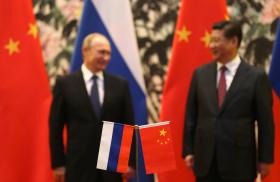
- Policy Analysis
- PolicyWatch 4078
Leveraging Iran’s Defeat to Strengthen U.S.-Iraq Security Relations

Tehran’s Iraqi proxies mostly sat out the twelve-day war, but this pragmatic restraint will not forestall growing U.S.-Iran competition over Iraq’s airspace, economic partnerships, and other sectors.
The recent military collision between Iran, Israel, and the United States did not formally involve Iraq, which took pains to declare that it was not party to the conflict. Yet Iraq’s airspace was widely used as a corridor for operations in both directions, just as it was during the two rounds of major Iran-Israel strikes in 2024—a pyrotechnic display that cannot have escaped the attention of the country’s Iran-backed militias. Even so, these groups largely stayed out of the twelve-day conflict, while the actions taken by relevant foreign players signaled an intent to exempt Iraq from most of the war’s effects.
Leveraging militia timidity, Washington should push forward with its quest to roll back Iranian influence in Iraq’s governance and energy sectors, taking advantage of the powerful momentum created by the war. At the same time, U.S. officials need to formulate a clear policy for securing Iraq’s airspace in a manner that preserves America’s interests—including U.S. freedom of action in any future crises.
Militias Stand Down
Iraqi militias played their hand quite differently in the current war compared to the conflict that erupted on October 7, 2023. After Hamas attacked Israel, Iraqi groups within Iran’s “axis of resistance” threatened to enter the conflict if the United States became involved, but then ignored their own red line and began launching drones at U.S. targets and Israel anyway. That sequence of tit-for-tat attacks ended with heavy U.S. strikes on Iraqi militia leaders, which deterred further attacks on American sites by March 2024. And in November, Jerusalem delivered a warning to Iraqi militias that similarly quieted their attacks on Israel.
During the latest war, however, Iraqi militias were much more restrained—all bark and (almost) no bite. On June 15, Kataib Hezbollah and Harakat Hezbollah al-Nujaba once again issued warnings that they would enter the fight if the United States did so. Yet this was a full three days into the war, suggesting that they waited for guidance from Tehran and were told not to attack—or were allowed to choose for themselves and still opted to stand down. There is certainly no evidence that Iraqi Prime Minister Mohammed Shia al-Sudani or his cabinet did anything to restrain militia action (in any case, they lack the leverage to stop these groups even if they tried).
In the end, Iraqi militias do not appear to have attacked Israel directly from their territory at any point during the war, though they may have aided sporadic drone attacks from southern Syria (if so, they were careful not to claim such participation). Even after the United States bombed Iran, the author’s detailed accounting of rocket and drone attacks inside Iraq suggests that militias mounted just one symbolic strike on a U.S. target: a two-drone attack against Erbil International Airport on June 22. Other signs of restraint were legion: protests organized by the militia social media network Sabereen News were kept distant from the U.S. embassy in Baghdad; a June 17 parliamentary session on condemning Israel’s attacks failed to achieve a quorum; and the traditional militia calls for evicting U.S. bases and diplomats were nowhere to be heard. Tellingly, a few small militia social media accounts berated the timidity of their leaders’ reaction to the war.
Uses and Abuses of Iraqi Airspace
Ever since the bulk of U.S. troops were withdrawn from Iraq in 2011, the country’s airspace has been a constant source of heartburn to all parties. The United States and Israel have long objected to its use as an Iranian “air bridge” to Syria and Lebanon, while Iraqi militias fear the freedom of operation that U.S. and Israeli air forces have to strike them from above at any time.
In theory, Iraq could combine its existing U.S. and French surveillance radars with various civilian radars to build an “air picture” of foreign military overflights. It also has a (very limited) number of Russian Pantsir S-1 interceptor missiles capable of reaching medium altitudes (15,000-50,000 feet), along with a number of interceptor aircraft (though all of them are U.S.-supplied F-16s carrying U.S.-supplied AIM-7M missiles). These weapons could have posed a risk to both non-stealthy Israeli aircraft and Iranian cruise missiles and drones transiting Iraqi airspace.
In practice, however, none of these capabilities were used during last month’s war. No Iraqi missiles are known to have been fired at any aircraft, missiles, or drones, despite the country’s airspace being saturated with them. Israeli aircraft overflew Iraq while attacking from the west and returning home from the east, often dropping auxiliary fuel tanks during these transits. They may also have engaged in air tanker refueling over Iraq (as they appear to have done over Syria). Meanwhile, most of the 1,000-plus drones and cruise missiles that Iran launched during the conflict passed through Iraqi airspace, while its ballistic missiles often shed their spent booster rockets on Iraqi soil. As for U.S. aircraft, they reportedly flew through Iraq on June 22 en route to striking Iran’s nuclear program.
As the war was coming to a close on June 23-24, at least two of Iraq’s surveillance radars were destroyed by mystery drone attacks at Camp Taji and Imam Ali Air Base, while others may also have been targeted unsuccessfully at Balad Air Base and al-Asad Air Base. This might have been an Israeli operation intended to cover the sudden withdrawal of personnel from Iran at the operation’s end using non-stealthy aircraft. If so, it may underline Israeli concerns that Iraqi air defenses could interfere with such movements or that the Iraqi “air picture” could be made available to Iran.
Implications for U.S. Policy
Among the war’s many important repercussions for U.S. policy toward Iraq, three stand out. First, Iran-backed militias remain very cautious about not provoking U.S. or Israeli strikes inside Iraq, and Tehran also seems to view this approach as prudent. Israel has largely abided by these rules as well, with the possible exception of hitting Iraqi radars at the war’s end. Even when targeting Haider al-Musawi—a key Iraqi militia commander involved with various operations in Syria—on June 21, Israel waited till after he transited Iraq and had just entered Iran before striking. Going forward, if Iran or its Iraqi proxies decide to test the boundaries of this apparent detente, Washington should remind them that any drone or missile launches originating in Iraq will result in U.S. strikes on senior militia commanders. If Washington does not police this red line, Israel undoubtedly will, potentially complicating the U.S. position in Iraq.
Second, Iraqi airspace issues require more careful handling, including a dedicated U.S. policy position on the matter. Toward the end of the war, both Maj. Gen. Rahim Safavi of Iran’s Islamic Revolutionary Guard Corps (IRGC) and the militia Harakat Hezbollah al-Nujaba criticized the Iraqi government for failing to defend the country’s skies. Calls for Baghdad to acquire more-capable non-U.S. air defense radars and interceptors were growing even before the war and will now become more urgent. For instance, in one reported $2.8 billion deal, Iraq would receive South Korean Cheongung-II medium-range missile defense systems, which incorporate elements of radars used with the Russian S-400. In response, the United States needs to develop an explicit policy position—not necessarily communicated publicly, but behind closed doors with Iraq’s military leadership—regarding the status of the country’s airspace. It should also apply various tools—such as arms sales, pressure on alternate suppliers, and sanctions leverage—to ensure that the end state of Iraq’s air defenses does not threaten U.S. interests or freedom of action.
Third, U.S. policy efforts in Iraq should be emboldened by the fact that no major faction attacked American facilities during the war or renewed the call to evict them. This was a powerful sign that Iran’s influence in Iraq has been (temporarily) reduced by the terrible beating Tehran sustained. Thus, while the U.S. embassy was partially evacuated during the fighting, all of its core functions should be returned to Baghdad as soon as possible. And while the Trump administration will likely seek to pare down the State Department presence when deciding who to redeploy, it should make sure that any such changes are limited to the margins and do not affect the core mission. The reasons for such urgency are clear—this is a moment of great opportunity for expanding U.S. influence in Iraq, protecting U.S. personnel and businesses there, and reducing Iran’s malign influence more permanently.
To give an example: on June 29, the Iran-backed head of Iraq’s Federal Supreme Court, Jassem Mohammed Abboud, was forced into retirement by a panel of nationalist judges—a step that would have been unthinkable before the war and would likely have failed if Iranian influence were not shaken. More such changes are possible, including continued efforts to remove Iranian influence within Iraq’s world-class energy sector. Indeed, U.S. officials envisioned this outcome in their July 3 decision to sanction a major Iraqi oil smuggler who simultaneously worked for the Iraqi government, the IRGC, and a host of U.S.-designated terrorist organizations.
Michael Knights is the Bernstein Senior Fellow at The Washington Institute and co-creator of its Militia Spotlight platform.



